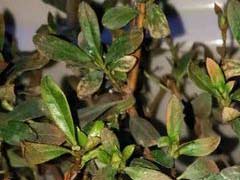Causes of yellow leaves of Catharanthus roseus
Catharanthus roseus is relatively solid-skinned flowers and plants, and the flowering period is very long. Generally speaking, the yellowing of the leaves of Catharanthus roseus is caused by improper maintenance, such as soil problems, and the soil needs to be tested for pH. Soil is slightly alkalineThe soil should be replaced if it is not suitable. If it is caused by improper watering, stop watering and place it in a well-ventilated place.
1. Soil problem
It does not have very high requirements on the soil, except for saline-alkali soil. If it is planted in alkaline soil, it will cause its leaves to turn yellow and not bloom. It is necessary to test the pH of the soil for planting. If the soil is alkaline, You can replace the soil with a loose soil that is acidic and rich in humus. Or you can add ferrous sulfate solution to the soil, which will not only acidify the soil, but also increase the fertility of the soil.
2. Improper watering
Catharanthus roseus is protected from dampness and waterlogging. Too much watering will affect root respiration and cause yellowing of old leaves and tender yellow for new leaves. Too little watering or long-term watering does not allow the plants to absorb sufficient water and leavesIt will also turn yellow and fall off. Too much watering will cause yellow leaves, so you need to stop watering and place it in a ventilated place, and dry the excess water in the basin. When too little watering causes yellow leaves, you need to add water in time.Strictly control the amount of watering, dry is better, and drainage should be paid attention to in rainy season.
3. Too much fertilizer
If too much fertilizer is applied, it will be difficult for the periwinkle to absorb completely, causing fertilizer damage. Fertilizer remains in the soil and always surrounds the roots, causing the entire periwinkle to grow weakly, grow slowly, and yellow the leaves. It is necessary to stop fertilizing immediately.Increase the amount of watering to dilute the excess fertilizer in the soil. When fertilizing Catharanthus roseus, alternate application of compound fertilizer and liquid fertilizer can be used instead of random fertilization. Watering the next day after fertilization can promote nutrient absorption.
- Related knowledge
- Is periwinkle suitable for indoor cultivation? There must be sunshine
- Catharanthus roseus cutting method picture
- The life span of five-petal plum is several years
- Does periwinkle have seeds?
- How to sow periwinkle
- How to grow Catharanthus roseus_Analysis of the yellow leaf phenomenon of Catharanthus roseus
- What are the essentials for periwinkle cultivation
- Picture of Catharanthus roseus
- Picture of Catharanthus roseus
- How to reproduce four season plums
 What's the matter with the leaves of azaleas withering and falling when touched
What's the matter with the leaves of azaleas withering and falling when touched- How to kill Xiao Hefei with how to cure Xiao Hefei
- Gardenia flower buds fall off
- What to do if the white palm leaves droop
 Brazilian wood leaves turn yellow
Brazilian wood leaves turn yellow Can carbendazim kill insects?
Can carbendazim kill insects? How to prevent root rot of Anthurium andraeanum flamingo
How to prevent root rot of Anthurium andraeanum flamingo Prevention methods for rhododendron brown spot disease
Prevention methods for rhododendron brown spot disease
- Editor's recommendation
- Causes and treatments for the yellowing of water-fed bamboo leaves
- Environmental protection method for killing red spiders and aphids
- How to deal with the rotten roots of Dripping Guanyin
- Solution to the yellowing of the leaves of the Ping An tree
- What should I do if the leaves of the Fortune Tree are yellow?
- 13 Reasons for Falling Leaves of Fortune Trees
- Prevention and treatment of common diseases in Wenzhu
- How to deal with the rotten roots of the rich tree
- Four reasons for the death of azaleas
- How to prevent root rot of Anthurium andraeanum flamingo





